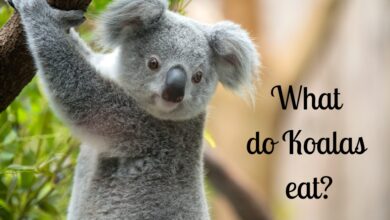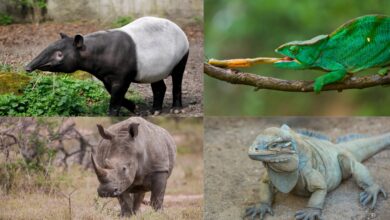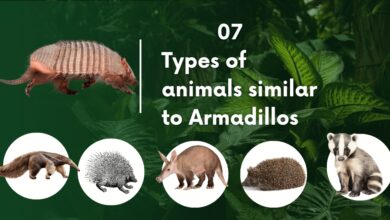10 types of animals like Gazelles
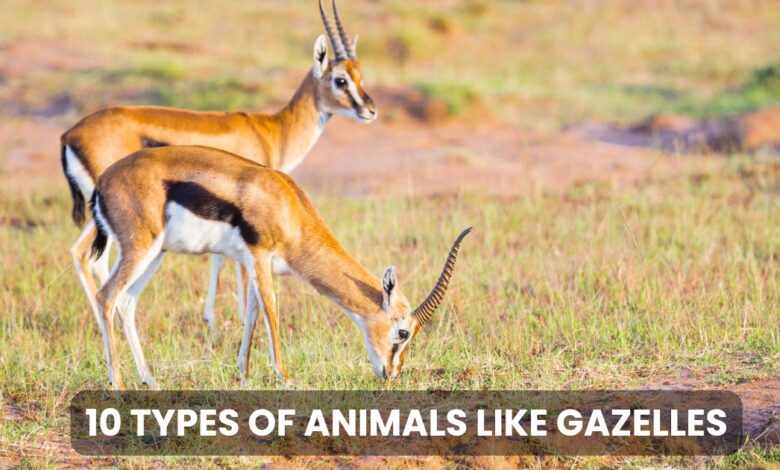
10 types of animals like Gazelles
Gazelles, elegant members of the antelope family, inhabit the deserts, savannahs, and grasslands of Africa, India, and central Asia. Among the seven gazelle species, the Thomson’s gazelle, native to Africa, is the most recognized, though nearly all gazelle species face endangerment or threats.
Typically light tan or fawn-colored, gazelles stand between two and three and a half feet tall at the shoulder, boasting a slender and delicate appearance often associated with feminine beauty. As migratory animals, gazelles are browsers, sourcing their diet from grass, leaves, and vegetation. Their adaptation to extracting most of their water from the vegetation is crucial in their semi-arid habitats.
However, as prey animals, they remain a favored target for predators such as lions, leopards, cheetahs, and crocodiles.
While gazelle-like animals are distributed across Africa, Europe, Asia, and North America, Africa hosts a diverse array of gazelle species and their antelope relatives. However, as prey animals, they remain a favored target for predators such as lions, leopards, cheetahs, and crocodiles.
Some of them are given below:
1. Impala
Impala knowns as Aepyceros melampus, A medium-sized antelope known for its distinctive, curved horns and impressive speed. Native to the savannas and grasslands of southern and eastern Africa, impalas, much like gazelles, are recognized for their agility.
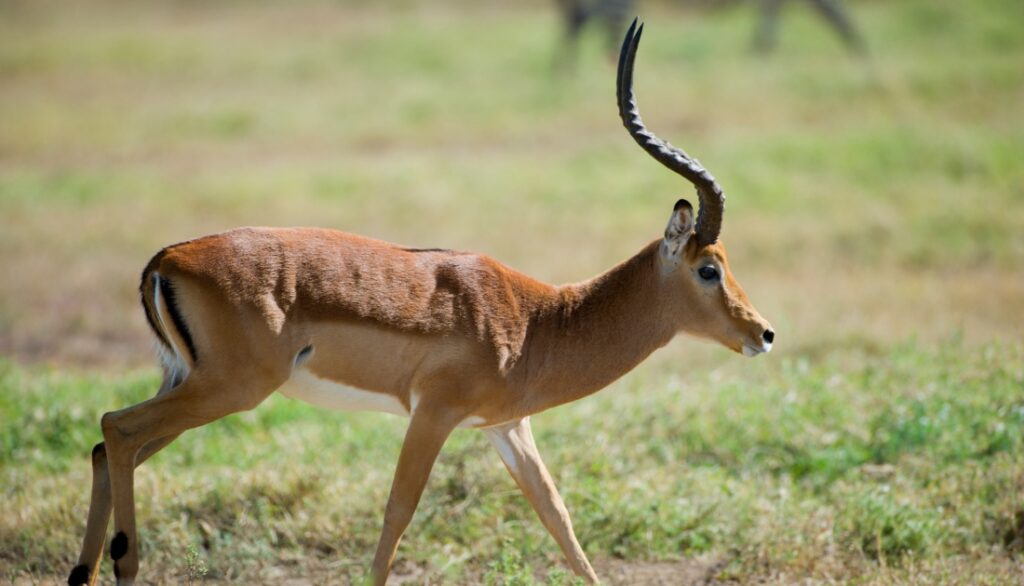
With the ability to reach speeds of about 50 miles per hour, impalas, although not sustaining this pace for long, showcase remarkable sprinting capabilities. Their leaping prowess is equally noteworthy, as they can jump up to 10 feet and cover approximately 30 feet in a single bound.
Marked by reddish-brown coats, white underbellies, and dark faces, male impalas sport unique, curved horns that can grow up to 36 inches. In contrast, females lack horns and are proportionately smaller.
Distinct from gazelles, impalas have a greater reliance on water, often found near water sources. They maintain a varied diet, grazing on grasses, flowers, fruits, leaves, and vegetables.
2. Springbok
The springbok, a captivating medium-sized antelope species, is distinguished by its stunning golden coat complemented by a white underbelly and a dark band running along its back.
Characterized by long, graceful legs and prominent ears, both male and female springboks boast horns that are black, between 15 and 20 inches long, with a distinctive curve at the end.
See Also: Can sloths swim Also? (Surprising fact)
Inhabiting the grasslands and savannahs of southern Africa, springboks, like gazelles, exhibit a social structure involving bachelor groups, all-female groups, and mixed harems. Facing threats from cheetahs, lions, leopards, jackals, African wild dogs, and human hunting for fur and meat, springboks are also vulnerable to large eagles, including the Verreaux’s eagle and tawny eagle, which can target their offspring.
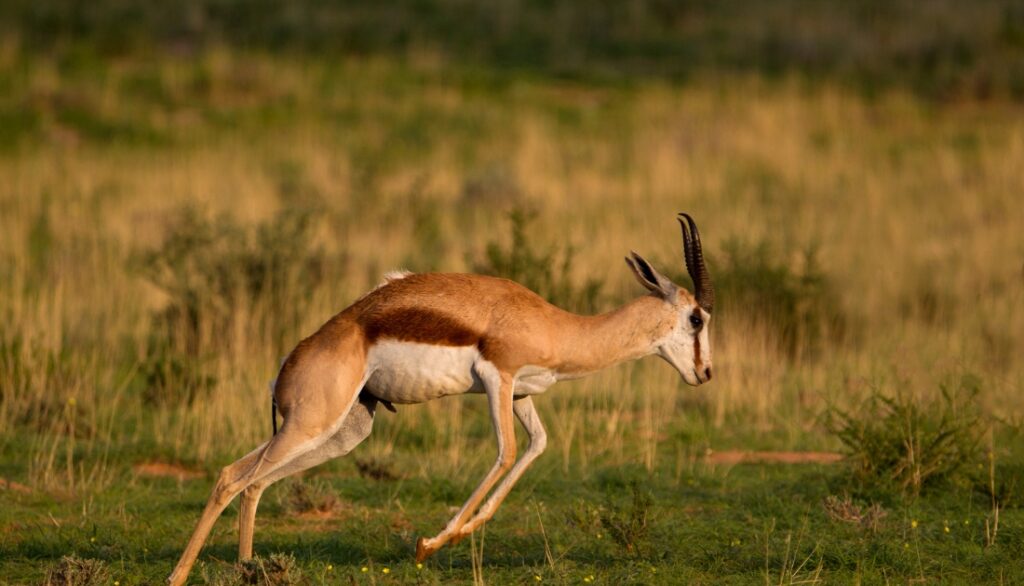
Similar to gazelles, springboks fulfill their water needs through their food, enabling them to endure entire dry seasons without requiring a drink. Meticulous browsers, they selectively consume succulent leaves, flowers, grasses, and seeds.
3. oribi
The oribi, often referred to as a dwarf antelope and considered the smallest ruminant, stands out as a unique species among antelopes. Bearing a striking resemblance to gazelles, the oribi is native to sub-Saharan Africa, characterized by its diminutive stature and reddish-brown coat.
With males adorned by a distinctive tuft of black fur on their foreheads, oribis typically reach heights ranging from 20 to 30 inches and weigh around 30 pounds.
Thriving in wooded habitats, grasslands, and savannas, oribis, akin to gazelles, possess the remarkable ability to fulfill their water requirements through their diet. Employing a zigzag running pattern to confound predators, oribis showcase agility and swiftness in their movements.
Capable of leaping up to three feet and bounding over six feet in length, oribis utilize their agility and speed, reaching speeds of up to 50 miles per hour, to evade predators during short bursts of acceleration.
4. Dik-Dik
The enchanting dik-dik, a slender, long-legged antelope, calls the bushlands of southern and eastern Africa its home. Adorned with a delicate frame, slender face, and expressive eyes, the dik-dik stands out as one of the more endearing members of the antelope family.
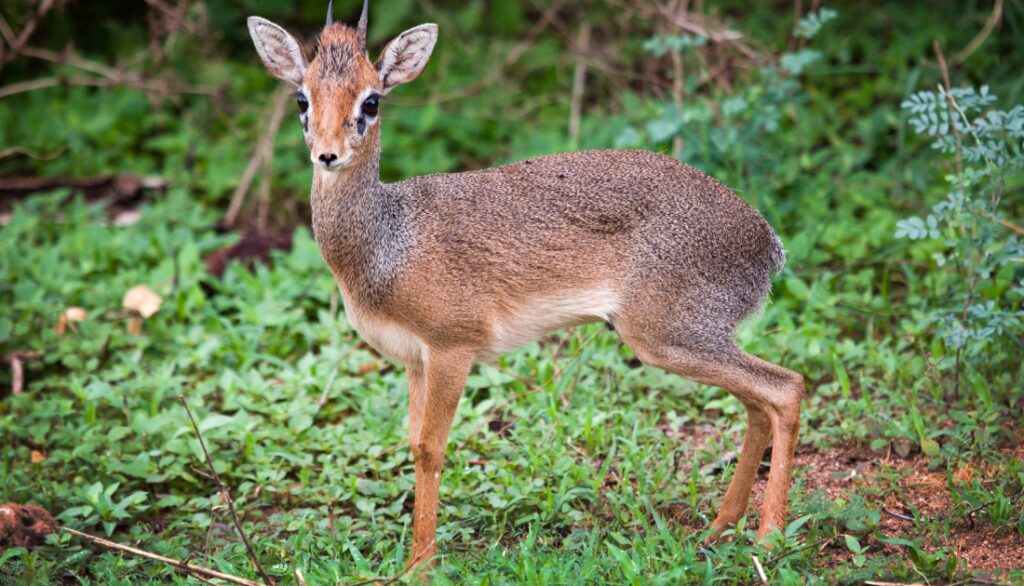
What makes the dik-dik even more intriguing is its nomenclature, derived from the distinct sound produced by female dik-diks when signaling danger.
Typically ranging from 12 to 15 inches tall at the shoulder, with females noticeably larger than males, the dik-dik holds a unique secret in its eyes. Each eye features a gland at the inner corner, secreting a sticky substance that allows the dik-dik to mark its territory by inserting twigs or leaves.
Male dik-diks boast grooved horns, measuring about three inches, and both genders exhibit a tannish-brown color with slightly lighter underbellies. The dik-dik’s charm lies not only in its appearance but also in its fascinating behaviors and adaptations to its environment.
5. Reedbuck
A notable feature distinguishing the three species of reedbuck, medium-sized African antelopes, is the forward curvature of the horns in males.
Named after their habitats, the southern reedbuck, mountain reedbuck, and bohor reedbuck thrive in diverse regions of sub-Saharan Africa. Their heights vary between 25 and 41 inches, with males slightly larger than females, depending on the species and location.
Mountain reedbucks share an adaptation with gazelles, allowing them to abstain from drinking water for extended periods, fulfilling their hydration needs through the consumption of green plants. In reedbucks, biologists observe a transition between solitary antelope species and those with complex social systems.
While reedbucks are not monogamous like klipspringers or social like springboks, they don’t exhibit complete solitude either. This nuanced social structure adds an interesting dimension to the behavior of these swift and adaptable antelopes.
6. Greater Kudu
Inhabiting the woodlands of eastern and southern Africa, the greater kudu stands out for its vocal prowess, showcasing a broader range of vocalizations compared to other antelope species.
Male kudus are known for their gasping, hissing, clucking, and grunting noises, creating a symphony of sounds. In contrast, the females are generally less vocal.
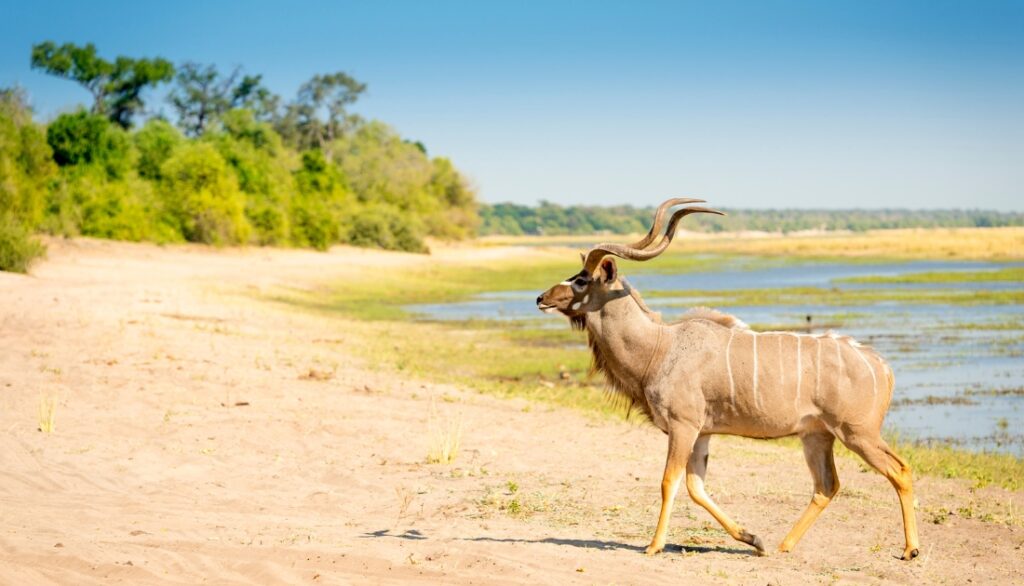
With coats ranging from tan to bluish-gray and reddish-brown, kudus exhibit distinctive white vertical stripes along their torsos, numbering between four and twelve.
Males boast goat-like beards and impressive long horns that gently twist, adding an elegant touch to their appearance. Additionally, males sport a captivating white zigzag marking between their eyes, further enhancing their unique and charismatic presence in the woodlands.
7. Roan Antelope
Named for its distinctive reddish-brown hue, the roan antelope thrives in the savannas of southern, western, and central Africa. With a striking appearance, this antelope features a black face adorned with white cheeks and eyebrows, accompanied by small beards and gracefully curved, long-ringed horns.
True to its scientific name, highlighting its horse-like build, the roan antelope stands as one of the largest members of the antelope species. With an average height of five and a half feet at the shoulders, males can impressively weigh up to 660 pounds.
Choosing diverse habitats, including scrublands, grasslands, woodlands, and savannas, these antelopes exhibit a social structure by forming harem herds. In these herds, one dominant male leads around a dozen females.
Adding to the richness of Africa’s wildlife, the roan antelope’s habitat often intersects with that of other African antelope species, creating a dynamic and interconnected ecosystem.
8. Tsessebe
The common tsessebe stands out as a distinctive antelope native to Africa, known for its remarkable speed—it ranks among the fastest of all antelope species, rivaled only by the gazelle, achieving speeds of nearly 58 miles per hour.
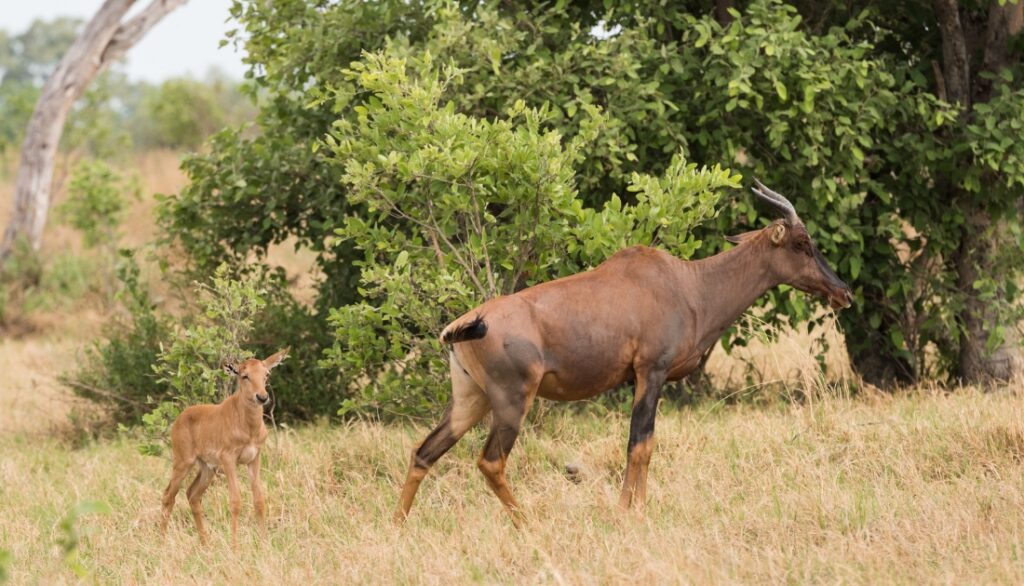
Young male tsessebes, once ousted, establish their herds, forming groups that may consist of up to three dozen youthful bulls.
Adding a touch of eccentricity, tsessebes exhibit peculiar behaviors during dominance and territorial battles. Males engage in ground-horning, high-stepping, and grunting in a display that continues to puzzle biologists.
9. East African Oryx
The East African oryx, a captivating medium-sized antelope, is renowned for its lengthy, straight, and elegantly ringed horns, a distinctive feature present in both males and females. Impressively thin, these horns can extend up to 30 inches in length.
Dressed in a palette of gray with contrasting white underbellies, the East African oryx exhibits a striking visual appeal. The transition between these hues is marked by a band of lustrous black fur, accentuated by additional black highlights on the neck, nose, forehead, and a defining stripe from the eye to the mouth.
In contrast to the gazelle, the East African oryx employs a unique water conservation strategy. By elevating its internal body temperature, it minimizes sweating and conserves water. This remarkable antelope efficiently stores water obtained from consuming leaves, fruits, and grasses, adapting ingeniously to its environment.
10. Nyala
A majestic large antelope adorned with a distinctive spiral horn, the nyala graces the landscapes of southern Africa, showcasing a remarkable kinship with its relatives, the goats.
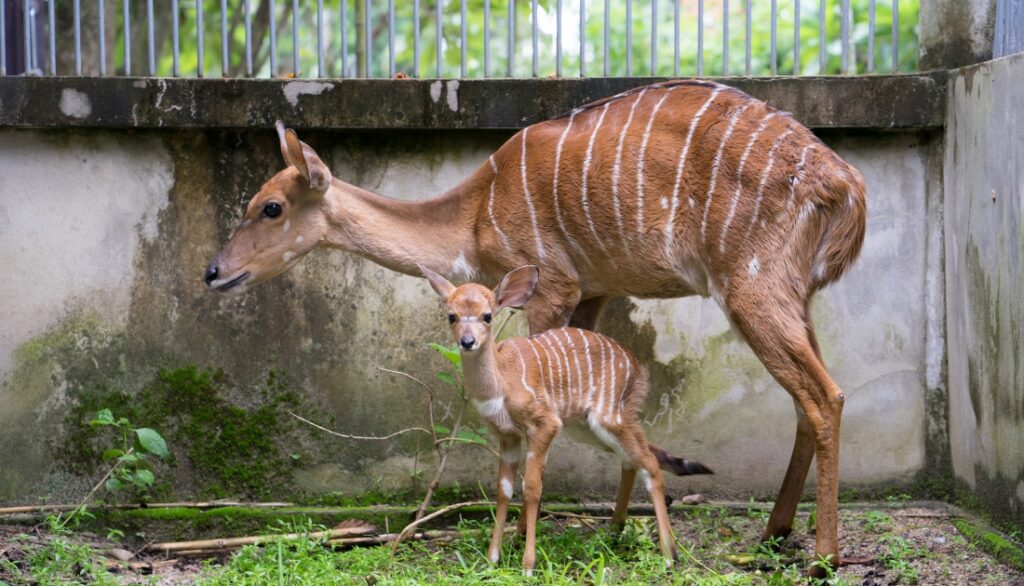
Distinguished by its long, shaggy fur, a departure from the short, sleek coats of gazelles and other antelope, the nyala presents a regal appearance. Notably, males exhibit beards and an elegant cascade of long fur around their necks, adding to their majestic presence.
In terms of coloration, male nyalas showcase brown or gray fur, while females exude an earthy elegance with brown coats adorned by ten or more distinctive white vertical stripes on their flanks.
Remarkably, the nyala boasts the most significant size disparity between males and females, with males towering up to a foot above their female counterparts.

